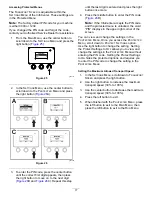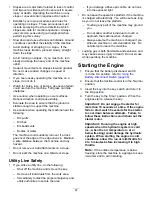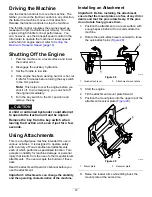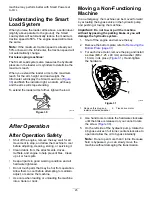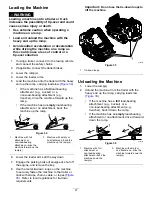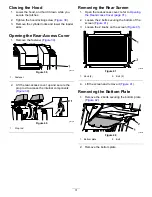
During Operation
During Operation Safety
General Safety
•
Do not transport an attachment/load with the
arms raised or extended; always transport the
attachments/load close to the ground, with the
loader arms retracted.
•
Do not exceed the rated operating capacity, as
the machine may become unstable, which may
result in loss of control. The operating capacity
is reduced if you extend the loader arms to the
point where you can see the striped decal inside
the arms.
•
Attachments can change the stability and the
operating characteristics of the machine.
•
For machines with a platform:
– Lower the loader arms before stepping off the
platform.
– Do not try to stabilize the machine by putting
your foot on the ground. If you lose control of
the machine, step off the platform and away
from the machine.
– Do not place your feet under the platform.
– Do not move the machine unless you are
standing with both feet on the platform and
your hands are holding onto the reference bars
or the loader control.
•
Use your full attention while operating the
machine. Do not engage in any activity that
causes distractions; otherwise, injury or property
damage may occur.
•
Look behind and down before backing up to
ensure that the path is clear.
•
Never jerk the controls; use a steady motion.
•
The owner/user can prevent and is responsible
for accidents that may cause personal injury or
property damage.
•
Wear appropriate clothing including eye protection,
long pants, substantial slip-resistant footwear, and
hearing protection; also wear a respirator or dust
mask in dusty conditions. Tie back long hair and
do not wear loose clothing or loose jewelry.
•
Do not operate the machine when you are tired, ill,
or under the influence of alcohol or drugs.
•
Never carry passengers and keep pets and
bystanders away from the machine.
•
Operate the machine only in good light, keeping
away from holes and hidden hazards.
•
Ensure that all the drives are in neutral before
starting the engine. Start the engine only from the
operator's position on the platform.
•
Use care when approaching blind corners, shrubs,
trees, or other objects that may obscure vision.
•
Slow down and use caution when making turns
and crossing roads and sidewalks. Watch for
traffic.
•
Stop the attachment when you are not working.
•
Stop the machine, turn off the engine, remove
the key, and inspect the machine if you strike
an object. Make any necessary repairs before
resuming operation.
•
Never run an engine in an enclosed area.
•
Never leave a running machine unattended.
•
Before leaving the operating position, do the
following:
– Park the machine on a level surface.
– Lower the loader arms and disengage the
auxiliary hydraulics.
– Engage the parking brake.
– Shut off the engine and remove the key.
•
Do not operate the machine when there is the risk
of lightning.
•
Operate the machine only in areas where there is
sufficient clearance for you to safely maneuver.
Be aware of obstacles in close proximity to you.
Failure to maintain adequate distance from trees,
walls, and other barriers may result in injury as the
machine backs up during operation if you are not
attentive to the surroundings.
•
Check for overhead clearance (i.e., electrical
wires, branches, and doorways) before driving
under any objects and do not contact them.
•
Do not overfill the attachment and always keep the
load level when raising the loader arms. Items in
the attachment could fall and cause injury.
Slope Safety
•
Operate the machine up and down slopes with
the heavy end of the machine uphill.
Weight
distribution changes with attachments. An empty
load-bearing attachment makes the rear of the
machine the heavy end, and a full load-bearing
attachment makes the front of the machine the
heavy end. Most other attachments make the front
of machine the heavy end.
•
Raising or extending the loader arms on a slope
affects the stability of the machine. Keep the
loader arms in the lowered and retracted position
when on slopes.
21











